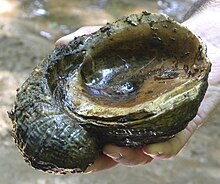Gryphaeidae
| Gryphaeidae Temporal range:
| |
|---|---|

| |
| An intact fossil shell of Exogyra flabellata (Owl Creek Formation, Late Cretaceous, Ripley, Mississippi), held in a human hand | |
| Scientific classification | |
| Kingdom: | |
| Phylum: | |
| Class: | |
| Order: | |
| Superfamily: | |
| Family: | Gryphaeidae
Vyalov, 1936 |
| Genera | |
|
See text | |

The Gryphaeidae, common name the foam oysters or honeycomb oysters, are a family of marine bivalve mollusks, and are a kind of true oyster. This family of bivalves is very well represented in the fossil record, however the number of living species is very few.
All species have shells cemented to a substrate. Shells are considered brittle, inequivalve, with the left, lower (cemented) valve convex and the right (upper, non-cemented) valve flat or slightly concave.[1]
Subfamilies
Genera and species within this family are divided into three subfamilies, Exogyrinae, Gryphaeinae and Pycnodonteinae. Both Exogyrinae and Gryphaeinae are completely extinct. Only four genera Hyotissa, Parahyotissa, Pycnodonte and Neopycnodonte in the subfamily Pycnodonteinae have extant species.[2]
Genera and species
Genera and species within the family Gryphaeidae include: Family Gryphaeidae Vialov, 1936 (some genera also known as Devil's toenails)
- Subfamily †Exogyrinae Vialov, 1936
- Genus †Aetostreon Bayle, 1878 (disputed)
- Genus †Amphidonte Fischer von Waldheim, 1829
- Genus †Costagyra Vialov, 1936
- Genus †Exogyra Say, 1820
- Genus †Fluctogyra Vialov, 1936
- Genus †Gryphaeostrea Conrad, 1865
- Genus †Gyrostrea Mirkamalov, 1963
- Genus †Nanogyra Beurlen, 1958
- Genus †Nutogyra Vialov, 1936
- Genus †Planospirites Lamarck, 1801
- Genus †Vultogryphaea Vialov, 1936
- Subfamily †Gryphaeinae Vialov, 1936
- Genus †Africogryphaea Freneix, 1963
- Genus †Deltoideum Rollier, 1917
- Genus †Gryphaea Lamarck, 1801
- Genus †Liostrea DouvillŽ, 1904
- Genus †Pernostrea Munier-Chalmas, 1864
- Genus †Praeexogyra Charles, 1952
- Subfamily Pycnodonteinae Stenzel, 1959
- Genus †Gigantostrea (Sacco, 1897)
- Genus Hyotissa Stenzel, 1971
- Genus †Labrostrea Vialov, 1936
- Genus Neopycnodonte Stenzel, 1971
- Genus †Pycnodonte (Fischer von Waldheim, 1835)
- Subfamily Incertae sedis
- Genus †Parahyotissa Harry, 1985
- Genus †Rhynchostreon
References
- ^ Jocelyne Martin; Gérard Paulmier (3 February 2011). Les invertébrés marins du golfe de Gascogne à la Manche orientale. Editions Quae. p. 82. ISBN 978-2-7592-0107-5.
- ^ The Paleobiology Database Gryphaeidae entry accessed on 6 February, 2011
